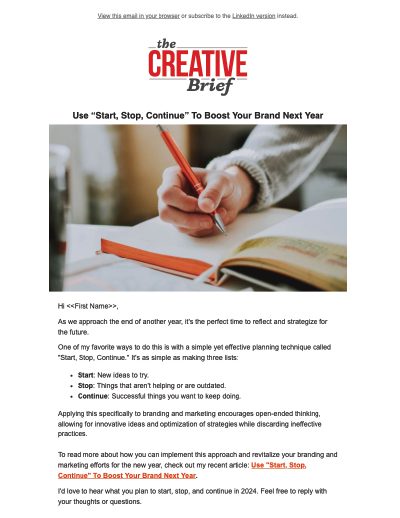Last year I wrote about some lessons learned while working in-house that makes me a better consultant and business owner. Today, I’m turning the tables and following up with some ideas for what I think helped shape my success when I was an in-house, corporate, creative.
I have been fortunate to work for some name-brand organizations as an in-house creative. But my career didn’t begin in-house. I started freelancing early, before even attending design school, and for a year after graduating from The School of Visual Arts (SVA) in New York. It was during these formative years of my career that I learned the difference between merely freelancing as a graphic designer, and consulting with clients to solve their most significant design challenges.
Design students at SVA learn how to be creative problem-solvers, developing original solutions to communications and design challenges. That meant not just designing something that merely looked good, but also solved a strategic need. We learned that you needed first to define the real challenge to be addressed. Often this required some digging and prodding from clients who typically came asking for what they thought the problem was when what they needed was something else much more specific and measurable.
This consulting mindset is something I brought to every cubicle and office I inhabited in-house whether I was designing apparel graphics at Banana Republic and Gap, or leading the teams at KPMG and Arizona Public Service. Here are the elements of a consulting mindset that I think will take you and your department from order-takers to creative problem-solving rock-stars!
Does it need to be a light-bulb?
You have undoubtedly heard a few “light bulb” jokes before. If none come to mind, let me entertain you for a moment:
Q: How many Psychiatrists does it take to change a light bulb?
A: Only one, but the bulb has got to really WANT to change.
Well, I heard this joke once, and it stuck with me:
Q: How many Graphic Designers does it take to change a light bulb?
A: Does it need to be a light bulb?
Sure it’s just a joke, but when you think about it, the best creative work comes out of being curious and not assuming that what the client wants is what they need. And our superpower is seeing things in a uniquely different way than other (dare I say normal) people. Don’t accept that the idea (AKA deliverable) the client asked for is the right solution to the problem.
Just because someone said “we need a photo of a sunset” doesn’t mean that a photo of a sunset will communicate the right message. Maybe an icon would be better because it’s going to be a 2-color print job, or it’s going to be so small that an image would be unrecognizable. Or maybe it’s not even a sunset at all, because what the client wants to convey is “a day at the beach with family.” In which case you might suggest sandcastles, a beach ball, sunscreen and a towel, or kids with sunburned shoulders.
Determine a shared measurement of success.
If you don’t want to be treated like an order-taker, then start behaving like a partner in the process. Partners work towards shared goals. Those goals should be discussed, negotiated, and understood by everyone at the onset of the project. The creative solutions your team dreams up should help your client achieve those goals.
I’m going to assume that you use some form of project or creative brief at the onset of any project. If you don’t, you should begin immediately, with the very next project request that comes into your department. A brief is like a roadmap for the project and the kind of solutions your team needs to develop. The client typically provides you with basic project information in a kick-off meeting, and you should follow-up with lots of questions to make sure you understand their needs and goals.
Knowing their strategic business goals is essential to know if the resulting deliverable at the conclusion of the project was successful. Include this line in your brief:
“The success of this project will be measured by [insert a non-subjective, qualitative or quantitative, form of measurement that aligns with business goals].”
For example: “The success of this project will be measured by a 15% increase in new subscriptions to our newsletter over a 60-day period.” Would be a great goal and measurement metric for a pop-up graphic on a website, aimed to get visitors to subscribe. It will also affect how your team approaches copywriting, image selection, design, and more. I can almost guarantee that “design something cool that will win an award” isn’t going to be a shared goal. So don’t worry about your department’s creative portfolio, as much as how well you are helping your internal clients to achieve business goals.
Detours, not roadblocks.
In-house teams tend to be very protective of brand assets, especially when clients make requests that require pushing the limits of what’s acceptable according to the brand guide. While it’s easy to say “no” to potentially brand-damaging or short-turnaround, requests you need to be mindful of appearing like you’re putting up roadblocks to solving their problem.
When someone asks for something you know you can’t produce because it’s off-brand, you can’t do it in the time they need it, or it’s just a bad idea, try this approach instead:
“No, we can’t do that. But what if we…”
Then brainstorm an alternate approach with your client. Use their suggestion as a launching point for new ideas and even team building. Strive to make flexibility and creativity the hallmark of your teams’ reputation.
It’s going to take small wins over time.
Working in-house means, you don’t get to choose your projects the way an outside agency might. So this shift from order-taker (whether real or perceived) is going to take some time. Look for the small wins with each project, and the big winds will come too. Try following-up with your client after a project has been delivered to see how it was received, and if they met their business goals. Talk about the positive results, and opportunities for improvement next time. You’re going to appear to be a partner, solutions provider, and creative rock-star for it.


